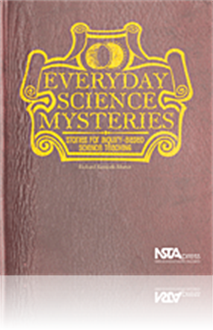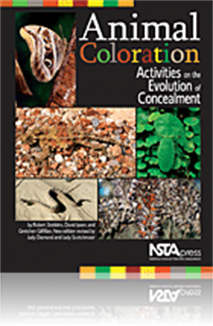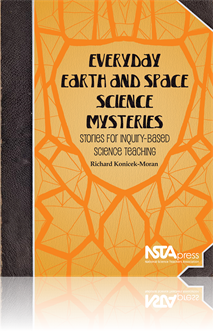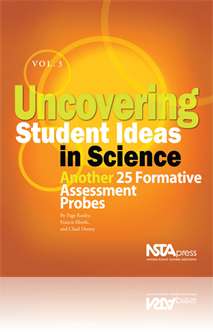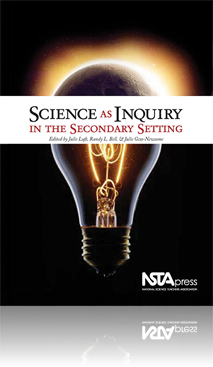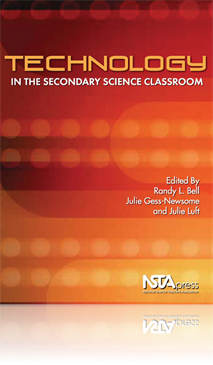All Book Chapters
Book Chapter
This story is aimed at promoting not only inquiry into the germination of tree seeds but seeing trees as typical flowering plants, also known as angiosperms. There is also ample opportunity to take an excursion into fruits and seeds and the germinati...
Book Chapter
For this story, the main purpose is to explore the relationship between temperature and pressure of gases but it may spill over into the concepts of floating and density in older children. It also asks questions about gas being a form of matter that ...
Book Chapter
Rolling objects are always fascinating for children. This story gives children an opportunity to find patterns in the process of rolling objects down ramps. Shades of Galileo! Since he was one of the first to actually do investigations by what “nat...
Book Chapter
The main purpose of studying the pendulum in this story is to provide a vehicle for finding and sorting out variables and designing a study for discovering the variable that controls the period (the time for a back and forth swing) of the pendulum. T...
Book Chapter
The Neighborhood Telephone System
This story uses the “tin can” telephone (TCT) as a focus for inquiry into the transmission of sound waves along a medium and also provides an opportunity for kids to try their hand at improving a simple device so that it works better. Students wi...
Book Chapter
Heat and cold are often difficult concepts for children to understand. First, our everyday sloppy language gives them a predisposition to such common misconceptions as cold being a substance that moves from place to place. Our colloquial language oft...
Book Chapter
Using the Book and the Stories
It is often difficult for overburdened teachers to develop lessons or activities that are compatible with the everyday life experiences of their students. A major premise of this book is that if students can see the real-life implications of science ...
Book Chapter
The Link Between Science, Inquiry, and Language Literacy
There is currently a strong effort to combine science and literacy, because a growing body of research stresses the importance of language in learning science. Discussion, argumentation, discourse of all kinds, group consensus, and social interaction...
Book Chapter
The apparent daily motion of the Moon and other celestial objects through the sky is a major science concept. This story is designed to call attention to the changes in position and shape of the Moon over time. Its purpose is to motivate students to ...
Book Chapter
The main purpose of the “Cheeks” story is to get the children to learn something about the behavior of shadows cast by objects in sunlight. Although the story takes liberties with the “thoughts and projections” of Cheeks, one can take it as m...
Book Chapter
This story is designed to spur an inquiry activity about the process of weathering and soil formation. Evidence lies all around us if we look closely enough and ask the right questions. Eddie is helping us by asking some of these questions and the au...
Book Chapter
The theme of the story can be summed up in one word: microclimates. Have you noticed that there are variations among the temperatures broadcasted on your radio or TV and your own thermometer? Have you noticed that there are differences in temperature...
Book Chapter
The incident described in this story actually happened to the author during a camping trip in Everglades National Park years ago. The humidity was fierce but the air cooled down and overnight he awoke to a wet face and wet pillow. This story is desig...
Book Chapter
Just what kinds of characteristics do living things receive from their parents and what kinds of traits do they not? What makes the offspring of any animal or plant have the basic characteristics of the parents? There happen to be a great number of h...
Book Chapter
Evolution and the Functions of Color
The purpose of the first activity is to stimulate students’ interest in the coloration of animals. While students may already be aware that the white coat of the polar bear provides some measure of concealment in the snowy surroundings of the Arcti...
Book Chapter
This activity introduces students to an animal that is to be the subject of much experimentation by them. Because most fish have a relatively simple form and exhibit a wide variety of colors and patterns, they prove to be an excellent animal for expe...
Book Chapter
In their study of animal coloration, the students will be “hiding” animals from themselves. If the students cannot easily spot a fish, they may assume that the fish will be overlooked by another fish or by a preying bird or mammal. If a moth esca...
Book Chapter
This chapter introduces an especially important subject in the concealment of animals—countershading. One observes many animals with colors that match the general color of their usual backgrounds. Many leaf-eating insects appear green, for example,...
Book Chapter
Concealment of Give-Away Parts
The outline of an animal is not the only feature that might give it away. Often some part of it, perhaps its eyes or its legs or its tail, might also be a clue. In this activity, these parts are called giveaway parts. The function of the first activi...
Book Chapter
A previous activity suggested the importance of behavior to an animal with coincident coloration. If the stripe-legged frog fails to fold its legs, the disruptive markings on them lose much of their effectiveness. If, when at rest, a moth with coinci...
Book Chapter
In this activity, students will be asked to review their experiments from the previous chapters. Throughout this book, the students have studied animal coloration through the use of models, rather than by investigating living animals. This activity g...
Book Chapter
The apparent daily motion of the Moon and other celestial objects through the sky is a major science concept. This story is designed to call attention to the changes in position and shape of the Moon over time. Its purpose is to motivate students to ...
Book Chapter
The purpose of this assessment probe is to elicit students’ ideas about the properties of atoms. The probe is designed to determine whether students can distinguish between the microscopic properties of an atom and the macroscopic properties of a s...
Book Chapter
Science Beyond the Curriculum: Projects and Challenges
The National Science Education Standards and Benchmarks for Science Literacy stress the importance of creating science experiences that are linked to the real world, something that is familiar to students. Projects and challenges hold the potential f...
Book Chapter
Crime scene evidence can include strands of human hair, an unidentified animal pelt, or animal hair on the ground near a suspected poaching. Hairs that look alike with the naked eye can become distinctly different when viewed under the microscope. In...
Book Chapter
What Is Inquiry? A Framework for Thinking About Authentic Scientific Practice in the Classroom
In this chapter, a framework is suggested for organizing teacher thinking about inquiry and prioritizing the wide assortment of activities teachers typically use to familiarize their students with the processes of science. This framework articulates ...
Book Chapter
Assessing Science as Inquiry in the Classroom
Assessments of inquiry should align with what we know about learning and should be balanced and authentic. That is, they should include all the important features of inquiry, not just those easy to assess. This approach helps ensure that all students...
Book Chapter
Inquiry and Scientific Explanations: Helping Students Use Evidence and Reasoning
This chapter describes the importance of scientific explanation in inquiry, common difficulties students have in justifying their claims, and a suggested instructional approach for supporting students in writing scientific explanations. It then discu...
Book Chapter
Historical Development of Teaching Science as Inquiry
This chapter examines four periods in the history of science education. In particular it looks at how societal pressures brought about the teaching of science as inquiry in each period and how educators, cognitive psychologists, and scientists have r...
Book Chapter
Inquiry experiences in the Earth sciences are often indirect, because direct experimentation, such as is used in the physical sciences, is typically not possible. To support inquiry in the Earth sciences it is important to consider the components of ...
Book Chapter
Inquiry in the Chemistry Classroom: Perplexity, Model Testing, and Synthesis
Lavoisier's theory of combustion is used as a context for a set of interrelated, inquiry-fostering investigations in a high school chemistry class. Further, this example of chemistry inquiry is used to develop some central ideas about inquiry pedag...
Book Chapter
Field Studies as a Pedagogical Approach to Inquiry
By designing and conducting their own field studies, students learn science in a meaningful context, apply scientific knowledge to local environmental issues, use resources within and around the school, and link classroom science to real-world issu...
Book Chapter
Creating Coherent Inquiry Projects to Support Students Cognition and Collaboration in Physics.
This chapter presents an inquiry template that involves three phases: (1) students observe and reflect on phenomena and make predictions about underlying mechanisms, (2) students gather data to investigate these mechanisms as they build and refine th...
Book Chapter
Inquiry-Based Science Instruction for Students with Disabilities
Students with disabilities often are struggling readers who cannot successfully access and use print information. As a result, they usually experience difficulties with traditional science instruction, which typically relies on textbooks and other pr...
Book Chapter
Scientific Inquiry: The Place of Interpretation and Argumentation
Secondary school students typically believe that scientific inquiry begins with a direct observation of the natural world and that scientific laws and theories become apparent from these observations. In reality, observation provides only highly infe...
Book Chapter
In Praise of Questions: Elevating the Role of Questions for Inquiry in Secondary School Science
If scientific inquiry is to be part of the focus in secondary school science, teachers must develop learning situations in which question posing is essential and they must help students learn how to pose scientifically oriented questions. In focusing...
Book Chapter
Educational Technology in the Science Classroom
Each year billions of dollars are invested in establishing an effective infrastructure for employing information technology in schools. Almost all classrooms have been wired for internet access, computers have been installed, and inservice sessions a...
Book Chapter
Essentially, technology use in the science classroom is most effective when it encourages deeper student engagement with science content, when it is used to support rather than replace what we know about effective science instruction, and especially ...
Book Chapter
Digital Images and Video for Teaching Science
New technologies have revolutionized our ability to see and learn scientific phenomena. Reasonably priced digital still and video cameras have recently become popular additions to many classrooms, and teachers use them regularly to document student l...
Book Chapter
Using Computer Simulations to Enhance Science Teaching and Learning
Technological advances have increasingly brought instructional digital technologies into the science classroom. Teachers may have greater access to Internet-connected classroom computers, wireless laptop carts, computer projectors, and interactive wh...



